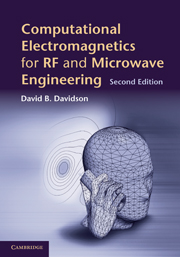Book contents
- Frontmatter
- Dedication
- Contents
- Preface to the second edition
- Preface to the first edition
- Acknowledgements
- To the reader
- List of notation
- 1 An overview of computational electromagnetics for RF and microwave applications
- 2 The finite difference time domain method: a one-dimensional introduction
- 3 The finite difference time domain method in two and three dimensions
- 4 A one-dimensional introduction to the method of moments: modelling thin wires and infinite cylinders
- 5 The application of the FEKO and NEC-2 codes to thin-wire antenna modelling
- 6 The method of moments for surface modelling
- 7 The method of moments and stratified media: theory
- 8 The method of moments and stratified media: practical applications of a commercial code
- 9 A one-dimensional introduction to the finite element method
- 10 The finite element method in two dimensions: scalar and vector elements
- 11 The finite element method in three dimensions
- 12 A selection of more advanced topics in full-wave computational electromagnetics
- Appendix A The Whitney element
- Appendix B The Newmark-β time-stepping algorithm References
- Appendix C On the convergence of the MoM Reference
- Appendix D Useful formulas for simplex coordinates
- Appendix E Web resources
- Appendix F MATLAB files supporting this text
- Index
- References
3 - The finite difference time domain method in two and three dimensions
Published online by Cambridge University Press: 05 July 2014
- Frontmatter
- Dedication
- Contents
- Preface to the second edition
- Preface to the first edition
- Acknowledgements
- To the reader
- List of notation
- 1 An overview of computational electromagnetics for RF and microwave applications
- 2 The finite difference time domain method: a one-dimensional introduction
- 3 The finite difference time domain method in two and three dimensions
- 4 A one-dimensional introduction to the method of moments: modelling thin wires and infinite cylinders
- 5 The application of the FEKO and NEC-2 codes to thin-wire antenna modelling
- 6 The method of moments for surface modelling
- 7 The method of moments and stratified media: theory
- 8 The method of moments and stratified media: practical applications of a commercial code
- 9 A one-dimensional introduction to the finite element method
- 10 The finite element method in two dimensions: scalar and vector elements
- 11 The finite element method in three dimensions
- 12 A selection of more advanced topics in full-wave computational electromagnetics
- Appendix A The Whitney element
- Appendix B The Newmark-β time-stepping algorithm References
- Appendix C On the convergence of the MoM Reference
- Appendix D Useful formulas for simplex coordinates
- Appendix E Web resources
- Appendix F MATLAB files supporting this text
- Index
- References
Summary
Introduction
In the previous chapter, the basic concepts of the finite difference time domain method were introduced via a one-dimensional example. We will briefly reprise the issues one must attend to when doing an FDTD simulation, as follows:
An FDTD mesh (or grid) must be created for the problem. (This is trivial in 1D, requires a little thought in 2D, and becomes quite a major problem in 3D.)
This mesh must be fine enough – i.e. Δs must be no more than perhaps one-tenth of the minimum wavelength (i.e. maximum frequency) of interest (Δs represents the spatial step size; quite often, Δx, Δy and Δz are chosen equal and Δs is used as shorthand for this).
The time step Δt must satisfy the Courant limit (but be as close to this as possible to minimize dispersion).
Boundary conditions (the source and load resistors in our 1D example) must be specified.
An appropriate signal shape (e.g. differentiated Gaussian) with suitable time duration for the desired spectral content must be chosen. Also, in general, its spatial position must be specified. (In the transmission line example, it was fixed as the source voltage generator.)
In this chapter, we will study the FDTD method in two and three dimensions. Firstly, we will develop a 2D simulator for a problem of scattering in free space. Following this, a very important development, the perfectly matched layer absorbing boundary condition, will be discussed and implemented.
- Type
- Chapter
- Information
- Publisher: Cambridge University PressPrint publication year: 2010



